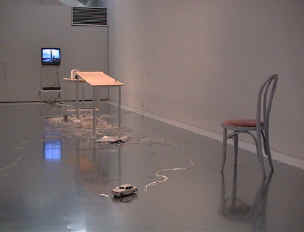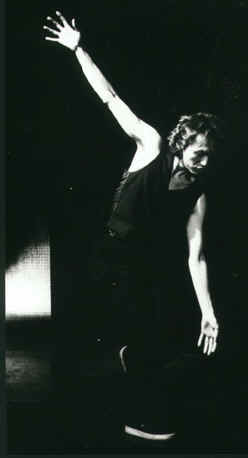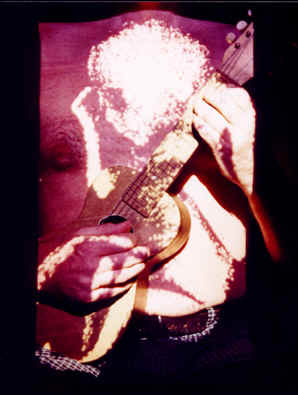SCENE ENVIRONMENT NATURE ANTINATURE
By Massimo Zanasi
 Natural
spaces, both the wild ones and those of the " fit out " places in villages
and towns, carry on a fundamental function, in the artistic communication,
alls language and as system of topological and symbolic references. In the
nature, we move and act every day and artistically: both in that land where
"lose himself" a là Thoreau, in the countryside, seas and mountains, and in
that technological one where "find himself again", in urban space, gardens,
squares, boulevards, along the rivers crossing the towns. On the space that
surrounds us, or where we place our researches, depend also the messages we
receive from all other the word. There is in fact affinity among the kinds
of behaviour, that can be considered as texts of the scenic culture, and the
continuous project and remanipulation of the earth and of the world.
Since the texts
of a culture can be lead to an abstract model, which often assumes natural
shapes, it is possible also to use places or earth scenes ad a metalanguage
for the research and testing in culture. The semantic interpretations, the
simplest keys of reading are those that go on by oppositions: internal/external,
inside/outside, near/far, body/space, nature/culture, etc. Then contemporaneous
theatrical and vanguard cultures tend to bring the point of view along the
borders of these opposites or even to turn over the sense of the more, or
less traditional models.
Natural
spaces, both the wild ones and those of the " fit out " places in villages
and towns, carry on a fundamental function, in the artistic communication,
alls language and as system of topological and symbolic references. In the
nature, we move and act every day and artistically: both in that land where
"lose himself" a là Thoreau, in the countryside, seas and mountains, and in
that technological one where "find himself again", in urban space, gardens,
squares, boulevards, along the rivers crossing the towns. On the space that
surrounds us, or where we place our researches, depend also the messages we
receive from all other the word. There is in fact affinity among the kinds
of behaviour, that can be considered as texts of the scenic culture, and the
continuous project and remanipulation of the earth and of the world.
Since the texts
of a culture can be lead to an abstract model, which often assumes natural
shapes, it is possible also to use places or earth scenes ad a metalanguage
for the research and testing in culture. The semantic interpretations, the
simplest keys of reading are those that go on by oppositions: internal/external,
inside/outside, near/far, body/space, nature/culture, etc. Then contemporaneous
theatrical and vanguard cultures tend to bring the point of view along the
borders of these opposites or even to turn over the sense of the more, or
less traditional models.
These research, of course, become complicated depending on the historical-cultural, contests and define better their outlines in the scenic action, from the rituals of the fiesta to the finest form of the cultured theatre, from the so-called poetry theatre till the present forms of the multimedial performance and of the installation. Theatre, based upon a precise codification of the "natural" spaces, gives nowaday great value to the frontiers of these spaces, through a permeability among all the elements of the scene, until the renunciation of the same theatrical architectures to recodify languages in other places, natural or symbolic. But theatrical space is always significant space, that means space producing sense even when it throws itself against it. Theatre in the reign of the symbolic forms even when it goes "against nature". In theatre nature is space to discover or lived space, invention and creativity. It is true that also earth is always somehow descripted, but scenic space is like a second skin, which is placed on the natural place to load it of aesthetic valences or to conquest to the culture universe growing parts of that territory not masse, sometimes unexplored, that constitutes the so-called wilderness in the dimension of the "beyond".
As a matter of fact, when the actor or the performer gets in touch with nature in an area not traditionally prepared, the physical place where it works becomes scenic coded space. This scenic natural space transforms from its own all the people who have exceeded the confines of the seat reserved to the audience and in general of the world out of this space and have entered his reign. Maybe because of it we are so enchanted by temples, theatres and ruins of history all over the earth, from Mediterranean country until the forests of Yucatan. Of course, when theatre (scene) gets into the nature it tends to take possession of this "magic" space, can handle it, mould it, but it become conditioned. While the internal spaces, equipped for this aim, are prevalently neutral, stagnant, as waiting for a scenic action, the earth natural spaces (and often magic) are formed by their continuous becoming and get the same flexibility of the poetic word, sharing the same risks.
In
this contaminated space (become "depute place"), actor/attaint ,
director, performer, artifex ad you wont to call them articulates and in-writes
(or writes again) his scenic speech on the ambiguous frontier that separates
signs of the nature and traces of the history. Here the way becomes impervious
and leans out on the abyss that separates us also one from another. We are
fast beyond the dimension of the "landscape", of the natural scene to use
to make a "performance" more interesting. Let's make a step backwards. Art
develops since human beings leave their community. During prehistory there
is no art. What we usually consider with this name is the materialization
of a cognitive faculty, though which man represent the word he does not live
in, separated, autonomized. It handles about an element of knowledge not abstract,
it means not only base on that modality as Leroi Gourhan(1)
says, comes from a multidirectional thought that spreads and stars a dialogue
with what surround it, since the separation, ha s not yet taken place. So
this, art, in present words called, is simultaneously language, science, magic,
rite, theatre, and so on, and at the same time part of a whole from which
it receives and gives a sense.
,
director, performer, artifex ad you wont to call them articulates and in-writes
(or writes again) his scenic speech on the ambiguous frontier that separates
signs of the nature and traces of the history. Here the way becomes impervious
and leans out on the abyss that separates us also one from another. We are
fast beyond the dimension of the "landscape", of the natural scene to use
to make a "performance" more interesting. Let's make a step backwards. Art
develops since human beings leave their community. During prehistory there
is no art. What we usually consider with this name is the materialization
of a cognitive faculty, though which man represent the word he does not live
in, separated, autonomized. It handles about an element of knowledge not abstract,
it means not only base on that modality as Leroi Gourhan(1)
says, comes from a multidirectional thought that spreads and stars a dialogue
with what surround it, since the separation, ha s not yet taken place. So
this, art, in present words called, is simultaneously language, science, magic,
rite, theatre, and so on, and at the same time part of a whole from which
it receives and gives a sense.
After the break, art and theatre will become means to make the ancient community live again, the "lost totality"; and since the immediate link does not work anymore, they will put themselves like mediation trying to re-establish the communication, "the radiant phenomenon"(2). From here is born the figure of the healer, the wizard explorer, the director of the beyond, expert in esoteric techniques, that with his "existential and exorcistic dramas" tries to protect his ethnia from all the destroying forces and to redeem them from a terrible confusion with the most uncontrollable elements, of the nature itself(3). With the greek theatre, opera, cinema, with all attempts to realize the total art, in the present epoch (you can verify it also in some projects of land-art and in some multimedial performances), this homesick, this research of lost community makes a name of itself, even though for the operators this thing cannot show under these terms.
It
is interesting to notice, about loss, absence (or end), that Mircea Eliade,
in 1963, said that contemporary art of the origins (between '800 and '900),
in this phase of destruction-creation of previous world and even sacking the
young forces of the so-called primitive folks, Amerindians or Africans, showed
a great interest for the origins, emphasizing the myth of the end of the world
in the contemporaneous era(4). Practically we can notice that actors/artifex/authors, writers-scompositors
of the scene, the demiurges of the "nothing", far from being neurotic (as
they are usually described), have realized that a real re-start can take place
only after a real end; and the very first vanguardists, as the cubofuturists
and the dadaists, have endeavoured to destroy their world trying to re-create
and artistic universe where the man can at the same time exist, contemplate
and dream. In reality, what has been created in the western countries (and
not only) after the thirties is a world where the mankind has always less
importance and meaning - and not from the humanistic point of view, just because
it has suffered a deep and maybe final spoliation by the externalisations
and representations of the "I" cause by the psycho-analysis. In this phase
the subject himself becomes art (market) and the art becomes system of international
communication pre-eminently, with its credits and its escapes forwards (and
backwards), and its art factories: fashion advertising, criticism as promotion
and censure, name.
Practically we can notice that actors/artifex/authors, writers-scompositors
of the scene, the demiurges of the "nothing", far from being neurotic (as
they are usually described), have realized that a real re-start can take place
only after a real end; and the very first vanguardists, as the cubofuturists
and the dadaists, have endeavoured to destroy their world trying to re-create
and artistic universe where the man can at the same time exist, contemplate
and dream. In reality, what has been created in the western countries (and
not only) after the thirties is a world where the mankind has always less
importance and meaning - and not from the humanistic point of view, just because
it has suffered a deep and maybe final spoliation by the externalisations
and representations of the "I" cause by the psycho-analysis. In this phase
the subject himself becomes art (market) and the art becomes system of international
communication pre-eminently, with its credits and its escapes forwards (and
backwards), and its art factories: fashion advertising, criticism as promotion
and censure, name.
It is not a case that the same Leroi-Gourhan pointed out already in the sixties(5) the trend absolutely not innocent to let disappear the separation between actors and audience because the performance must be prepared with the complicity of all the human beings, moved by some illusion makers whose task is to mediate, they are the mediators between language of the art and requirements of the market: those who are called nowadays, by mistake "cultural operators". Therefore there is an alternative to the interpretation that Ernesto De Martino - joining his historical scepticism with the analytic existencial language of Heidegger - gave of some sciaman techniques suited to strengthen "the being in the world" facing the risk of not-being; in the present societies many artists (or those who can be considered the present healers of the earth), poets and theatre makers in particular, choose the a-modality of a "not-being"(6) facing the risk of being as an alienated presence by the diffuse spectacularizations, by the same forms of the massmediatic communication.
Massimo Zanasi
BIBLIOGRAPHIC NOTES
1. Cfr. The gesture and the word, by Leroy-Gourhan, Turin, Einaudi, 1977.
2. V. The revelation, by Jacques Camatte, Milan, La Pietra, 1978.
3. V. The man of the limit, by Placido Cherchi, Naples, Liguori, 1994.
4. V. Myth and reality, by Mircea Eliade, Milan, Rusconi, 1974.
5. Op. cit.: The text, in its first French edition, dated 1964.
6. V. The magic world. By Ernesto De Martino, Turin. Boringhieri, 1973.